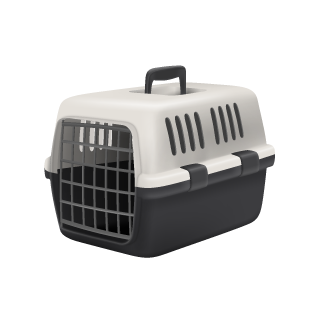
27 Jan
How to Move My Pet Internationally from India
There was a time in the Indian subcontinent when travelling across borders while in the sky was inconceivable. Fast forward a few years, and on June 8, 1948, Air India made its maiden international flight. Flying 25 passengers to London, the plane signified the dawn of a new era, and we’ve never looked back since.
Today, such travel can be cumbersome and akin to a chore. The excitement of such a journey has somewhat faded away, with international travel now commonplace for a host of reasons, such as vacations, business, or to meet family. While it has gotten boring for us humans, why keep the service restricted to humans?
Pet adoption rates have steadily risen over the years, as having a pet in the vicinity is directly linked to having a more joyous atmosphere. Few feelings are as satisfying as coming home from a long day of work, and finding your pet awaiting your arrival at the doorstep. It has evolved to the point where pets are not ‘pets’, but a part of the family unit itself, and a fundamental one at that.
While provisions for flying people internationally are widely available, the same are available for pets, and yet people are sceptical of the process. Whether that’s due to a lack of information or a fear of the unknown, the fact is their scepticism is unfounded, and flying is perhaps the most important method of transporting pets. Especially over long distances, which international journeys usually entail.
Relocating from one country to another is no easy task. There is the matter of cultural and societal norms to follow, languages to learn, and food to get used to, which can feel overwhelming after the initial journey. Another aspect pf travel which brings great stress to pet parents is deciding whether to take their beloved along with them, or to leave them behind.
A lot of people are not as informed on the subject as they could be, and wrongfully assume the technicalities cannot be fulfilled and their pet cannot fly with them. If anything, there are pet relocation providers to ensure such a situation never arises, to oversee a smooth journey overseas for your pet, and to simplify the process to the point where you just need to fill a few forms and submit the necessary documents.
Pet Transportation is of two kinds:
-
International Pet Relocation Import (bringing pets into the country from overseas)
-
International Pet Relocation Export (helping pets leave and travel to an overseas country)
Regardless of whether your move is domestic or international, you will need to follow the procedure and fulfil necessary requirements such as filling out paperwork, procuring permits, and so on. While the requirements for a domestic move remain constant, the requirements for an international move vary from country to country, with a different set of guidelines for the import and export of a variety of pets.
Once you’ve connected with your pet relocation expert and discussed the nature, requirements, and timeframe of your move, you will have to begin the process of arranging for everything you’ll need for your move.
Here Are the Basics You’ll Need for Your Move:
1. Passport Details

You will require your passport, airway ticket, a copy of your visa, and other relevant travel details, as the details of the owner(s) are needed to export your pet from India.
2. Proof Of Residence For Pet Transport

In order to acquire an import permit, you will need to provide documentation which can verify your continuous stay in India for a minimum period of two years, in case of pet export. For pet import, if arriving from overseas yourself, you will need a proof of transfer of residence to do so.
3. Documentation For Pet Relocation

Photographs, travel details, and pet-specific details such as their name, age, breed, size, and anything else relevant to your move.
4. Pet Crate

A pet crate is a strong enclosure, which keeps your pet safe while travelling. Pets cannot be unrestrained while travelling, therefore a pet crate is a mandatory requirement, and without the correct crate, your pet will not be allowed to fly. Due to safety and regulatory reasons, the International Air Transport Association (IATA) requires all pets to travel in a fiber crate, and airlines will only permit IATA-approved crates on board. Choosing the correct crate is important for your pet’s safety and comfort, so choose the correct crate before your travels.
5. In-Cabin Vs Cargo

Depending on your move, your pet may travel in-cabin, or in the cargo hold. Most international flights will require your pet to travel in the cargo hold. A pet-friendly airline will have temperature and pressure-controlled bay, making it as safe as the cabin. You’ll have to inform the airline while making your booking that you plan to travel with your pet, after which they will make the necessary modifications to your booking to accommodate your pet.
6. Documentation

You are required to submit a set of documents to the Animal Quarantine and Certification Service (AQCS), and if your move requires it, the Directorate General of Foreign Trade (DGFT). An import license is required to import pets for a short period (tourist visa) or for a change in ownership, which can be obtained from the DGFT. You need to book a appointment with the AQCS and submit your pet for examination before you can obtain an export NOC.
7. NOC (No Objection Certificate)

A NO Objection Certificate (NOC) is required when a pet is transferred. In order to obtain this document, a quarantine period is involved to ensure your pet is healthy and isn’t carrying any infectious diseases. You’ll need to procure an NOC from the AQCS, as mentioned in the previous step.
8. Vaccination Record

Your pet’s vaccination record serves as their passport, so it is important to keep it safe and up to date. Make sure the record is complete and the relevant health certificate affixed to the same.
9. Rabies Titer Test For Pet Travel

This test is performed to measure the effectiveness of a recent rabies vaccine, and whether the level of antibodies developed is sufficient to ward off any potential future infections. As India is classified as a high-rabies country, you’ll likely need the results of a titer test affixed to your pet’s vaccination record.
10. Fit To Fly Certificate

A fit-to-fly certificate is filled in by your authorized veterinarian, and confirms your pet is healthy and in flying condition.
11. Pet Microchip

A pet microchip is the only real proof of ID your pet can have. Aside from record keeping purposes, most countries list a et microchip as one of the mandatory import requirements, and even if they don’t, the AQCS does, which means you need a microchip before applying for an export NOC. Microchips are of the standard, non-encrypted, 15-digit variety, and accepted globally.
12. Pet Friendly Taxi

Booking an appropriate vehicle for travel to/from the airport is important. Specialized vehicles must be arranged for, as normal taxis hold the right to refuse your pet entry. You can arrange for a pet taxi, or let your pet relocation company manage it on your behalf.
13. Animal Quarantine

Pet quarantine may be imposed, depending on your destination country’s rules and regulations. Managing the specifics of quarantine in another country can be overwhelming, so consider hiring professionals for the same, if your destination is notorious for its rigorous requirements.
14. Professional Help
If you have further queries or require your pet to be relocated, call (890) 890-9020 or mail us at enquiry@carrymypet.com. We provide domestic and international pet relocation services, with the ease of access of a door-to-door relocation, whether inland or overseas.







AUTHOR’S BIO
Carry My Pet
Passionate pet enthusiasts and globetrotters, dedicated to easing furry friends' journeys worldwide. Penning tales of compassion at CarryMyPet, where every relocation is a tail-wagging adventure.